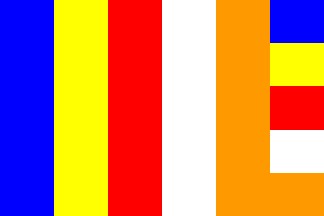International Buddhist Flag
Posted on February 15th, 2019
Rajendra Alwis
We come across evidence in the annals of history that the flag (Dhaja) has been in use since the dawn of civilization. Dhajagga Sutta of Samyutta Nikaya, sermonized by the Buddha is a case in point. In this sutta, the Buddha has made references to the flag of the Sakka, the King of the Deities, in order to give some instructions to the monks on how to cope with perilous situations by contemplating on the triple gem; Buddha, Dhamma and Sangha. We can glean from this sutta that the flag in this context, has been used as a symbol of identity, superiority and victory.
The Buddhist flag now in use was originally designed in 1885 by the Colombo Committee, in Colombo, Sri Lanka. The Committee consisted of Ven. Hikkaduwe Sri Sumangala Thero (chairman), Ven. Migettuwatte Gunananda Thero, Don Carolis Hewavitharana (father of Anagarika Dharmapala), Andiris Perera Dharmagunawardhana, William de Abrew, Charles A. de Silva, Peter de Abrew, H. William Fernando, N. S. Fernando and Carolis Pujitha Gunawardena (secretary).
The idea of the Buddhist flag is the brainchild of Pujitha Gunawardena who was the secretary of this Committee. He also played the main role in designing the flag. The invention of the Buddhist Flag was widely published in the Sarasavi Sandaresa newspaper of 17 April 1885 and it was first hoisted in public on Vesak full moon day of 28th April 1885 at the Dipaduttamarama, Kotahena, by Ven. Migettuwatte Gunananda Thero.
This was the first Vesak public holiday facilitated under the British rule. Colonel Henry Steel Olcott, an American journalist, founder and first president of the Theosophical Society in Sri Lanka, felt that the long streaming shape of the Buddhist Flag made it inconvenient for general use. Therefore, he suggested modifying it to bring it on par with the size and shape of the Sri Lankan National Flag. Accordingly, the suggested modifications were incorporated into the existing Buddhist Flag which was introduced by the Colombo Committee. The modified flag was again published in the Sarasavi Sandaresa of 8th April 1886 and it was first hoisted on the Vesak full moon day of 1886. In 1889 the modified flag was introduced to Japan by Anagarika Dharmapala and Colonel Olcott and the Emperor of Japan accepted it and subsequently it was also introduced to Burma
At the inaugural conference of the World Fellowship of Buddhists held on 25th May 1950, its founder President Professor G P Malasekera proposed that this flag be adopted as the International Buddhist Flag to be used throughout the world to represent the Buddhist faith and this motion was unanimously passed at the conference.
The five colors of the flag represent the six colours of the aura which Buddhists believe radiated from the body of the Buddha when he attained Enlightenment: blue (neela) yellow (peetha) red (loohitha) white (oodatha) scarlet (maanjestha) and the mixture of all these colours (prabaswara). The horizontal stripes of the Buddhist Flag represent the races of the world living in harmony with each other and the vertical stripes represent eternal world peace. The colours symbolize the perfection and purity of Buddhahood and the Dhamma preached by the Buddha.

In the classical Pali literature, the Buddha was also named as adichcha bandhu” meaning ‘the relative of the sun’. This honourary name has been conferred to the Buddha to compare some of the sun’s qualities with the certain qualities of the Buddha such as radiating colours, combining colours into pristine white (prabaswara), treating everyone alike regardless of race, creed, colour or ethnicity as the sun emanates its light equally to everyone.
Thus some Buddhist luminaries hold the view that the concept of adichcha bandhu” is graphically depicted in the Buddhist flag. Looking through a more philosophical lens it can be interpreted that attaining enlightenment is seeing beyond the six sensors, eyes, ears, nose, tongue, body and mind. The five vertical colour strips of the Buddhist flag represent the mundane five sensors and the horizontal strips with the combination of all the five colours (prabaswara) represent the enlightened mind, beyond the mundane five sensors, the attainment of the ultimate bliss of Nibbaana.